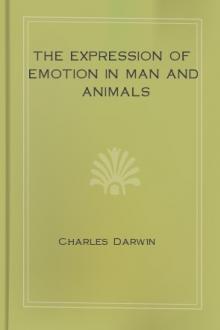The Expression of Emotion in Man and Animals, Charles Darwin [snow like ashes series txt] 📗

- Author: Charles Darwin
- Performer: -
Book online «The Expression of Emotion in Man and Animals, Charles Darwin [snow like ashes series txt] 📗». Author Charles Darwin
Nevertheless some, if not utterly degraded, are capable of blushing.
A microcephalous idiot, for instance, thirteen years old, whose eyes brightened a little when he was pleased or amused, has been described by Dr. Behn,[3] as blushing and turning to one side, when undressed for medical examination.
Women blush much more than men. It is rare to see an old man, but not nearly so rare to see an old woman blushing. The blind do not escape.
Laura Bridgman, born in this condition, as well as completely deaf, blushes.[4] The Rev. R. H. Blair, Principal of the Worcester College, informs me that three children born blind, out of seven or eight then in the Asylum, are great blushers. The blind are not at first conscious that they are observed, and it is a most important part of their education, as Mr. Blair informs me, to impress this knowledge on their minds; and the impression thus gained would greatly strengthen the tendency to blush, by increasing the habit of self-attention.
[2] Dr. Burgess, ibid. p. 56. At p. 33 he also remarks on women blushing more freely than men, as stated below.
[3] Quoted by Vogt, `Memoire sur les Microcephales,’
1867, p. 20. Dr. Burgess (ibid. p. 56) doubts whether idiots ever blush.
The tendency to blush is inherited. Dr. Burgess gives the case[5] of a family consisting of a father, mother, and ten children, all of whom, without exception, were prone to blush to a most painful degree.
The children were grown up; “and some of them were sent to travel in order to wear away this diseased sensibility, but nothing was of the slightest avail.”
Even peculiarities in blushing seem to be inherited. Sir James Paget, whilst examining the spine of a girl, was struck at her singular manner of blushing; a big splash of red appeared first on one cheek, and then other splashes, variously scattered over the face and neck.
He subsequently asked the mother whether her daughter always blushed in this peculiar manner; and was answered, “Yes, she takes after me.”
Sir J. Paget then perceived that by asking this question he had caused the mother to blush; and she exhibited the same peculiarity as her daughter.
In most cases the face, ears and neck are the sole parts which redden; but many persons, whilst blushing intensely, feel that their whole bodies grow hot and tingle; and this shows that the entire surface must be in some manner affected. Blushes are said sometimes to commence on the forehead, but more commonly on the cheeks, afterwards spreading to the ears and neck.[6] In two Albinos examined by Dr. Burgess, the blushes commenced by a small circumscribed spot on the cheeks, over the parotidean plexus of nerves, and then increased into a circle; between this blushing circle and the blush on the neck there was an evident line of demarcation; although both arose simultaneously.
The retina, which is naturally red in the Albino, invariably increased at the same time in redness.[7] Every one must have noticed how easily after one blush fresh blushes chase each other over the face.
Blushing is preceded by a peculiar sensation in the skin.
According to Dr. Burgess the reddening of the skin is generally succeeded by a slight pallor, which shows that the capillary vessels contract after dilating. In some rare cases paleness instead of redness is caused under conditions which would naturally induce a blush.
For instance, a young lady told me that in a large and crowded party she caught her hair so firmly on the button of a passing servant, that it took some time before she could be extricated; from her sensations she imagined that she had blushed crimson; but was assured by a friend that she had turned extremely pale.
[4] Lieber `On the Vocal Sounds,’ &c.; Smithsonian Contributions, 1851, vol. ii. p. 6.
[5] Ibid. p. 182.
I was desirous to learn how far down the body blushes extend; and Sir J. Paget, who necessarily has frequent opportunities for observation, has kindly attended to this point for me during two or three years.
He finds that with women who blush intensely on the face, ears, and nape of neck, the blush does not commonly extend any lower down the body.
It is rare to see it as low down as the collar-bones and shoulder-blades; and he has never himself seen a single instance in which it extended below the upper part of the chest. He has also noticed that blushes sometimes die away downwards, not gradually and insensibly, but by irregular ruddy blotches. Dr. Langstaff has likewise observed for me several women whose bodies did not in the least redden while their faces were crimsoned with blushes. With. the insane, some of whom appear to be particularly liable to blushing, Dr. J. Crichton Browne has several times seen the blush extend as far down as the collar-bones, and in two instances to the breasts.
He gives me the case of a married woman, aged twenty-seven, who suffered from epilepsy. On the morning after her arrival in the Asylum, Dr. Browne, together with his assistants, visited her whilst she was in bed.
The moment that he approached, she blushed deeply over her cheeks and temples; and the blush spread quickly to her ears. She was much agitated and tremulous. He unfastened the collar of her chemise in order to examine the state of her lungs; and then a brilliant blush rushed over her chest, in an arched line over the upper third of each breast, and extended downwards between the breasts nearly to the ensiform cartilage of the sternum.
This case is interesting, as the blush did not thus extend downwards until it became intense by her attention being drawn to this part of her person.
As the examination proceeded she became composed, and the blush disappeared; but on several subsequent occasions the same phenomena were observed.
[6] Moreau, in edit. of 1820 of Lavater, vol. iv. p. 303.
[7] Burgess. ibid. p. 38, on paleness after blushing, p. 177.
The foregoing facts show that, as a general rule, with English women, blushing does not extend beneath the neck and upper part of the chest.
Nevertheless Sir J. Paget informs me that he has lately heard of a case, on which he can fully rely, in which a little girl, shocked by what she imagined to be an act of indelicacy, blushed all over her abdomen and the upper parts of her legs.
Moreau also[8] relates, on the authority of a celebrated painter, that the chest, shoulders, arms, and whole body of a girl, who unwillingly consented to serve as a model, reddened when she was first divested of her clothes.
It is a rather curious question why, in most cases the face, ears, and neck alone redden, inasmuch as the whole surface of the body often tingles and grows hot. This seems to depend, chiefly, on the face and adjoining parts of the skin having been habitually exposed to the air, light, and alternations of temperature, by which the small arteries not only have acquired the habit of readily dilating and contracting, but appear to have become unusually developed in comparison with other parts of the surface.[9] It is probably owing to this same cause, as M. Moreau and Dr. Burgess have remarked, that the face is so liable to redden under various circumstances, such as a fever-fit. ordinary heat, violent exertion, anger, a slight blow, &c.; and on the other hand that it is liable to grow pale from cold and fear, and to be discoloured during pregnancy.
The face is also particularly liable to be affected by cutaneous complaints, by small-pox, erysipelas, &c. This view is likewise supported by the fact that the men of certain races, who habitually go nearly naked, often blush over their arms and chests and even down to their waists.
A lady, who is a great blusher, informs Dr. Crichton Browne, that when she feels ashamed or is agitated, she blushes over her face, neck, wrists, and hands,—that is, over all the exposed portions of her skin.
Nevertheless it may be doubted whether the habitual exposure of the skin of the face and neck, and its consequent power of reaction under stimulants of all kinds, is by itself sufficient to account for the much greater tendency in English women of these parts than of others to blush; for the hands are well supplied with nerves and small vessels, and have been as much exposed to the air as the face or neck, and yet the hands rarely blush.
We shall presently see that the attention of the mind having been directed much more frequently and earnestly to the face than to any other part of the body, probably affords a sufficient explanation.
[8] See Lavater, edit. of 1820, vol. iv. p. 303.
[9] Burgess, ibid. pp. 114, 122. Moreau in Lavater, ibid.
vol. iv. p. 293.
Blushing in the various races of man.—The small vessels of the face become filled with blood, from the emotion of shame, in almost all the races of man, though in the very dark races no distinct change of colour can be perceived.
Blushing is evident in all the Aryan nations of Europe, and to a certain extent with those of India. But Mr. Erskine has never noticed that the necks of the Hindoos are decidedly affected.
With the Lepchas of Sikhim, Mr. Scott has often observed a faint blush on the cheeks, base of the ears, and sides of the neck, accompanied by sunken eyes and lowered head.
This has occurred when he has detected them in a falsehood, or has accused them of ingratitude. The pale, sallow complexions of these men render a blush much more conspicuous than in most of the other natives of India. With the latter, shame, or it may be in part fear, is expressed, according to Mr. Scott, much more plainly by the head being averted or bent down, with the eyes wavering or turned askant, than by any change of colour in the skin.
The Semitic races blush freely, as might have been expected, from their general similitude to the Aryans. Thus with the Jews, it is said in the Book of Jeremiah (chap. vi.
15), “Nay, they were not at all ashamed, neither could they blush.”
Mrs. Asa Gray saw an Arab managing his boat clumsily on the Nile, and when laughed at by his companions, “he blushed quite to the back of his neck.” Lady Duff Gordon remarks that a young Arab blushed on coming into her presence.[10]
Mr. Swinhoe has seen the Chinese blushing, but he thinks it is rare; yet they have the expression “to redden with shame.” Mr. Geach informs me that the Chinese settled in Malacca and the native Malays of the interior both blush. Some of these people go nearly naked, and he particularly attended to the downward extension of the blush.
Omitting the cases in which the face alone was seen to blush, Mr. Geach observed that the face, arms, and breast of a Chinaman, aged 24 years, reddened from shame; and with another Chinese, when asked why he had not done his work in better style, the whole body was similarly affected.
In two Malays[11] he saw the face, neck, breast, and arms blushing; and in a third Malay (a Bugis) the blush extended down to the waist.
The Polynesians blush freely. The Rev. Mr. Stack





Comments (0)